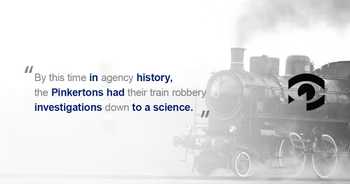On Friday, September 15, 1893, the morning train on the Mineral Range Railroad, a railway only twenty miles in length that ran between the prosperous frontier mining towns of Houghton and Calumet, Michigan, left the Hancock station, punctual to the minute. Ten minutes later at precisely 9:40 am, at the isolated and dilapidated “flag stop” Boston station, two passengers exited the express car, and three masked and armed men boarded. One entered the cab. He immediately thrust the engineer away from the throttle, which he took himself, and kept the train moving at the rate of about four miles an hour with the touch of an expert.
The other two men broke into the express car and demanded the Calumet & Hecla Mine payroll. Facing their revolvers, the Adams Express Company messenger, Dominick Hogan, unhesitatingly handed over the payroll, containing $70,000, all cash.
The robbers deposited the money into two bags and leapt out of the express car. One fired a shot into the air to signal the throttle man, who also leapt but not before admonishing the engineer, “Keep her going.” The three masked men disappeared into the nearby woods.
Deputized and dispatched
The engineer did, indeed, keep the train going for a few miles to the nearest telegraph station, where he sent notice that they were robbed. Immediately the sheriff, the police, and the marshal deputized and dispatched 50 men to search the woods. Another 50 men were sent from the mines, and a local group known as the Calumet Light Guard began to search for the bandits.
Within hours the news reached the Adams Express Company, one of the largest express delivery services of the day and one of Pinkerton’s oldest clients. Without hesitation William “The Eye” Pinkerton took the case. The next morning, Pinkerton, who traveled overnight by a special train from Chicago, arrived at the scene of the robbery on horseback.
After questioning the train’s crew, Pinkerton and his operatives fanned out across the countryside to interview as many as they could find, standard operating procedure following a train robbery. By this time in agency history, the Pinkertons had their train robbery investigations down to a science. Pinkerton theorized that those who lived in vast rural areas tended to be more observant, even hungry for the slightest morsel of news and conversation.

That morning a Pinkerton operative heard from a farmer’s wife that she had seen a strange red buggy with red wheels and a blanketed horse tied to a tree near the Boston crossing only a few hours before the robbery. She also served the operative a hearty breakfast and regaled him with stories from the farm.
Other operatives heard similar stories from eyewitnesses who said they had seen three men with a blanket covering their faces riding in a red buggy out of the woods.
A horseman at heart
Pinkerton himself took the lead and located the spot where the horse had been tied. He identified several long strands of black horsehair caught in the bark of the tree, but what caught the detective’s attention were the hoofprints in the dirt. As an equine expert who owned his own stable, Pinkerton knew the prints had been made by a horse shod with racing plates, a distinctively unusual feature for the area. Most horses were shod with heavy shoes for working the hilly and rocky farmland. And according to the horse’s gait, Pinkerton surmised they were looking for a pacer.
So, that afternoon they searched the county for a pacer shod with racing plates. Within two hours one operative reported that he found the animal and its owner, Jack Kehoe, a saloonkeeper — who also owned a red buggy. He reported that, according to the stable hand, Jack King, a friend of Kehoe and a former Cornish wrestling champion, had ridden the buggy out of town at 8 a.m. on the morning of the robbery, returning about 10 a.m.
Interview with a madam
But that’s not all. Operatives located a woman who operated a house of assignation who said that King and Kehoe met with the express messenger Dominick Hogan and Jack Butler, an ex-convict with an unsavory reputation, at her place of business a few nights before the robbery and again the day before the robbery.
Another operative discovered that the night following the robbery, a man named George LaLiberty, who had at one time been employed as a fireman on the Duluth, South Shore & Atlantic Railroad, hopped a ride on the train from Marquette to Houghton, and he did so without wanting to pay to check his trunk. After some rough words with LaLiberty, the depot’s baggageman said LaLiberty paid, and he thought he saw LaLiberty toss something behind some baggage at the depot but paid little attention to what that might have been.
Leaving no stone or baggage unturned, Pinkerton and his men emptied the baggage room and discovered a rough black mask made from the lining of a coat, similar to the ones that the train crew had described the robbers as wearing.
LaLiberty’s confession
On September 18, 1893, Pinkerton, the local law enforcement, and railroad officials arrested LaLiberty, who immediately made a full confession. Scorned, he stated that he was swindled out of his share of the loot and named Kehoe, King, Butler, Hogan, and Hogan’s brother, Edward, as the masterminds behind the train robbery. Everyone except Kehoe, who had an alibi for the time of the robbery — eyewitnesses place him on a drunken spree in a neighboring town — were arrested, convicted, and sentenced to five years in the Michigan State Penitentiary.
The case had taken only 72 hours to solve, and Pinkerton recovered all but $65.00 of the stolen payroll.





